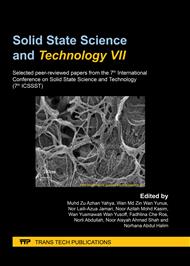[1]
A. Pekarovicova, V. Husovska, Printing Ink Formulations, in J. Izdebska, S. Thomas, Printing on Polymers, Elsevier Inc., 2016, p.41–55.
DOI: 10.1016/b978-0-323-37468-2.00003-8
Google Scholar
[2]
L.-Q. Tao, K.-N. Zhang, H. Tian, Y. Liu, D.-Y. Wang, Y.-Q. Chen, Y. Yang, T.L. Ren, Graphene-Paper Pressure Sensor for Detecting Human Motions, ACS Nano 11(9) (2017) 8790–8795.
DOI: 10.1021/acsnano.7b02826
Google Scholar
[3]
T. Das, B.K. Sharma, A.K. Katiyar, J.-H. Ahn, Graphene-based flexible and wearable electronics, J. Semicond. 39(1) (2018) 11007, (2018).
DOI: 10.1088/1674-4926/39/1/011007
Google Scholar
[4]
H. Tian, T.-L Ren, D.Xie, Y.-F. Wang, C.-J. Zhou, T.-T. Feng, D. Fu, Y. Yang, P.-G. Peng, L.-G. Wang, L.-T. Liu, Graphene-on-Paper Sound Source Devices, ACS Nano 5(6) (2011) 4878–4885.
DOI: 10.1021/nn2009535
Google Scholar
[5]
G. Hu, J. Kang, L.W.T. Ng, X. Zhu, R.C.T. Howe, C.G. Jones, M.C. Hersam, T. Hasan, Functional inks and printing of two-dimensional materials, Chem. Soc. Rev. 47(9) (2018) 3265–3300.
DOI: 10.1039/c8cs00084k
Google Scholar
[6]
J. Li, F. Ye, S. Vaziri, M. Muhammed, M. C. Lemme, M. Östling, Efficient Inkjet Printing of Graphene, Advanced Materials, 25(29) (2013) 3985–3992.
DOI: 10.1002/adma.201300361
Google Scholar
[7]
E.S. Ferreira, Graphite exfoliation in cellulose solutions, Nanoscale 9 (2017) 10219–10226.
Google Scholar
[8]
P.M. Carrasco, S. Montes, I. Garcia, M. Borghei, H. Jiang, I. Odriozola, G. Cabanero, V. Ruiz, High-concentration aqueous dispersions of graphene produced by exfoliation of graphite using cellulose nanocrystals, Carbon 70 (2014) 157-163.
DOI: 10.1016/j.carbon.2013.12.086
Google Scholar
[9]
R. Kabiri, H. Namazi, Surface grafting of reduced graphene oxide using nanocrystalline cellulose via click reaction, Journal of Nanoparticle Research 16 (2014) 2474.
DOI: 10.1007/s11051-014-2474-3
Google Scholar
[10]
Y. Tang, Z. He, J. Alexander, Production of highly electro-conductive cellulosic paper via surface coating of carbon nanotube / graphene oxide nanocomposites using nanocrystalline cellulose as a binder, Cellulose 21 (2014) 4569–4581.
DOI: 10.1007/s10570-014-0418-9
Google Scholar
[11]
Q. Zhang, C. An, S. Fan, S. Shi, R. Zhang, J. Zhang, Q. Li, D. Zhang, X. Hu, J. Liu, Flexible gas sensor based on graphene/ethyl cellulose nanocomposite with ultra-low strain response for volatile organic compounds rapid detection, Nanotechnology 29(28) (2018) 285501.
DOI: 10.1088/1361-6528/aabf2f
Google Scholar
[12]
G. Pandey, S.K. Yadav, B. Mishra, Preparation and characterization of isoniazid and lamivudine co-loaded polymeric microspheres, Artif. cells, nanomedicine, Biotechnol. 44(8) (2016) 1867–1877.
DOI: 10.3109/21691401.2015.1111229
Google Scholar
[13]
K. Pan, Y. Fan, T. Leng, J. Li, Z. Xin, J. Zhang, L. Hao, J. Gallop, K.S. Novoselov, Z. Hu, Sustainable production of highly conductive multilayer graphene ink for wireless connectivity and IoT applications, Nat. Commun. 9(1) (2018) 5197.
DOI: 10.1038/s41467-018-07632-w
Google Scholar
[14]
K. Kamide, K. Okajima, K. Kowsaka, Dissolution of Natural Cellulose into Aqueous Alkali Solution: Role of Super-Molecular Structure of Cellulose, Polym. J. 24(1) (1992) 71–86.
DOI: 10.1295/polymj.24.71
Google Scholar
[15]
A. Isogai, L. Science, R.H. Atalla, F. Service, Dissolution of cellulose in aqueous NaOH solutions, Cellulose 5 (1998) 309–319.
Google Scholar
[16]
A. Capasso, A. Del Rio Castillo, H. Sun, A. Ansaldo, V. Pellegrini, F. Bonaccorso, Ink-jet printing of graphene for flexible electronics: Towards an environmentally-friendly approach, Solid State Commun. 224 (2015) 53-63.
DOI: 10.1016/j.ssc.2015.08.011
Google Scholar
[17]
Y. Çelik, E. Flahaut, E. Suvacı, A comparative study on few-layer graphene production by exfoliation of different starting materials in a low boiling point solvent, FlatChem 1 (2017) 74–88.
DOI: 10.1016/j.flatc.2016.12.002
Google Scholar
[18]
M.S. Dresselhaus, A. Jorio, M. Hofmann, G. Dresselhaus, R. Saito, Perspectives on Carbon Nanotubes and Graphene Raman Spectroscopy, Nano Lett. 10(3) (2010) 751–758.
DOI: 10.1021/nl904286r
Google Scholar


